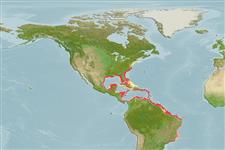>
Carangiformes (Jacks) >
Carangidae (Jacks and pompanos) > Trachinotinae
Etymology: Trachinotus: Greek, trachys, -eia, -ys = rough + Greek,noton = back (Ref. 45335).
More on author: Linnaeus.
Environment: milieu / climate zone / depth range / distribution range
ນິເວດວິທະຍາ
ສັດທະເລ; ນ້ຳກ່ອຍ ກ່ຽວກັນຫີນ; ລະດັບຄວາມເລິກ 0 - 36 m (Ref. 3277), usually 0 - 30 m (Ref. 55175). Subtropical; 42°N - 25°S, 100°W - 30°W (Ref. 55175)
Western Atlantic: Massachusetts, USA to southeastern Brazil, including Bahamas and many of the West Indies (Ref. 7251). Reports from Africa are based on misidentifications, mostly referring to T. teraia (Ref. 81654).
Length at first maturity / ຂະໜາດ / ນ້ຳໜັກ / Age
Maturity: Lm 54.7, range 48 - ? cm
Max length : 122 cm FL ຕົວຜູ້/ບໍ່ມີເພດ; (Ref. 40637); common length : 94.0 cm FL ຕົວຜູ້/ບໍ່ມີເພດ; (Ref. 3277); ນ້ຳໜັກສູງສຸດທີ່ເຄຍຈັດພີມມາ: 36.0 kg (Ref. 5217); ອາຍຸສູງສຸດທີ່ເຄຍລາຍງານມາ: 23 ປີ (Ref. 42149)
ຄີ (ໜາມ)ແຂງຢູ່ຫຼັງປາ (ທັງໝົດ): 6 - 7; ຄີຫຼັງຂອງປາ (ຄີອ່ອນ) (ທັງໝົດ): 18-21; ຄີ(ໜາມ) ແຂງຢູ່ຄີກົ້ນປາ
ກຸ່ມປາກະດູກແຂງ
ຄວາມຖີ່ຂອງກຸ່ມຖ່າຍທອດພັນ
ປາທີ່ມີການເຄື່ອນຍ້າຍຈາກທະເລໄປຫານ້ຳຈືດ ແລະນ້ຳຈືດຫາທະເລ
ປາທີ່ມີການເຄື່ອນຍ້າຍຈາກທະເລແລະໄປໄຂ່ຢູ່ນ້ຳຈືດ
ຄີກົ້ນຂອງປາ
ສັດທີ່ມີກະດູກສັນຫັຼງ
ການຖ່າຍທອດທາງກຳມະພັນຈາກພໍ່ແມ່ຫາລູກ 2-3; ຄີກົ້ນຂອງປາ: 16 - 18. Dorsal and anal fins have very long, dark anterior lobes (Ref. 26938). No scutes; a broad patch of orange-yellow on abdomen in front of anal fin; pectoral fins blackish (Ref. 13442).
Adults frequently in channels or holes, over sandy flats, around reefs, and at times over mud bottoms; usually solitary or in small schools; smaller fish tolerate brackish water. Spawn offshore (Ref. 26938). During the summer, juveniles are found in large schools especially in the surf zone along sandy beaches. Adults feed on mollusks, crabs, shrimps, and small fishes; juveniles on benthic invertebrates. Excellent food fish (Ref. 9626). Highly esteemed game fish caught on light tackle (Ref. 26938).
Life cycle and mating behavior
ການຈະເລີນເຕັມໄວ | ການສືບພັນ | ການວາງໄຂ່ | ໄຂ່ | ຄວາມດົກຂອງໄຂ່ປາ | ຕົວອ່ອນ
Robins, C.R. and G.C. Ray, 1986. A field guide to Atlantic coast fishes of North America. Houghton Mifflin Company, Boston, U.S.A. 354 p. (Ref. 7251)
IUCN Red List Status (Ref. 130435)
Threat to humans
Harmless
Human uses
Warning: mysqli::__construct(): (08004/1040): Too many connections in /var/www/html/includes/func_getlabel.php on line 46
Can't connect to MySQL database (fbapp). Errorcode: Too many connections
